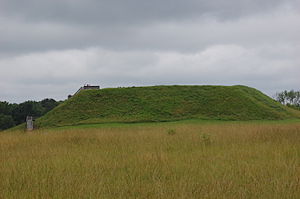Окмалги (национальный памятник): различия между версиями
| [отпатрулированная версия] | [отпатрулированная версия] |
Нет описания правки |
|||
| Строка 5: | Строка 5: | ||
== История == |
== История == |
||
Следы доколумбовых культур в долине реки Окмалги отмечены со времён [[последнее оледенение|последнего оледенения]] ок. 10 тыс. лет назад, когда здесь жили примитивные охотники-собиратели, и до прихода индейцев [[маскоги]] непосредственно перед появлением европейцев. Between 900—1150, an elite society supported by skillful farmers lived on this site near the [[Ocmulgee River]]. They constructed a town of rectangular wooden buildings, huge pyramidal temple [[mound]]s, and at least one [[burial mound]]. Circular [[earth lodge]]s served as places to conduct meetings and ceremonies. |
|||
After this large early ceremonial center declined, other villages were built in the area by the later [[Mississippian culture|Mississippian]] «Lamar» Culture. These were the people encountered by [[Spaniard]] [[Hernando de Soto (explorer)|Hernando de Soto]] in 1540. During historic times, the great mounds continued to evoke awe and admiration. [[Natural history|Naturalist]] [[William Bartram]] journeyed through Ocmulgee in the 1770s and described the «wonderful remains of the power and grandeur of the ancients in this part of America.» In the early 1900s, the area was put into a large renovation, and the site was made into its present manifestation. |
After this large early ceremonial center declined, other villages were built in the area by the later [[Mississippian culture|Mississippian]] «Lamar» Culture. These were the people encountered by [[Spaniard]] [[Hernando de Soto (explorer)|Hernando de Soto]] in 1540. During historic times, the great mounds continued to evoke awe and admiration. [[Natural history|Naturalist]] [[William Bartram]] journeyed through Ocmulgee in the 1770s and described the «wonderful remains of the power and grandeur of the ancients in this part of America.» In the early 1900s, the area was put into a large renovation, and the site was made into its present manifestation. |
||
Версия от 11:56, 26 июня 2009
Страницу в данный момент активно редактирует участник Dmitri Lytov. |


Национальный памятник Окмалги, англ. Ocmulgee National Monument — исторический и археологический памятник коренных культур юго-востока США, в том числе курганы миссисипской культуры. Расположен к востоку от города Мейсон, штат Джорджия.
История
Следы доколумбовых культур в долине реки Окмалги отмечены со времён последнего оледенения ок. 10 тыс. лет назад, когда здесь жили примитивные охотники-собиратели, и до прихода индейцев маскоги непосредственно перед появлением европейцев. Between 900—1150, an elite society supported by skillful farmers lived on this site near the Ocmulgee River. They constructed a town of rectangular wooden buildings, huge pyramidal temple mounds, and at least one burial mound. Circular earth lodges served as places to conduct meetings and ceremonies.
After this large early ceremonial center declined, other villages were built in the area by the later Mississippian «Lamar» Culture. These were the people encountered by Spaniard Hernando de Soto in 1540. During historic times, the great mounds continued to evoke awe and admiration. Naturalist William Bartram journeyed through Ocmulgee in the 1770s and described the «wonderful remains of the power and grandeur of the ancients in this part of America.» In the early 1900s, the area was put into a large renovation, and the site was made into its present manifestation.
National Monument
On June 14, 1934, the park was authorized as a National Monument, which was formally established on December 23, 1936, under the National Park Service. As an historic unit of the Park Service, the National Monument was administratively listed on the National Register of Historic Places on October 15, 1966. Ocmulgee has a visitor center that houses an archaeological museum that interprets the cultures of the Native Americans who had inhabited this site. A short orientation film and gift shop are also available in the visitor center.
The park has 5½ miles (9 km) of walking trails. Near the visitor center is a reconstructed thousand-year-old ceremonial earthlodge. Visitors can reach the Great Temple Mound via a half-mile walk or the park road. Other features in the park include a burial mound, temple mounds, prehistoric trenches, and the site of a colonial British trading post.
The main section of Ocmulgee National Monument is accessible from U.S. Route 80, off of Interstate 16 (which passes through southwest edge of the monument). It is open daily except Christmas Day and New Year’s Day. Lamar Mounds is an isolated unit of the monument, located in the swamps about 3 miles (5 km) south of Macon. The Lamar Unit is open on a limited basis. This site is smaller than Moundville Archaeological Park in Moundville, Alabama.
Ссылки
- Official NPS website: Ocmulgee National Monument
- LostWorlds.org | Ocmulgee Mounds
- Lamar Mounds coordinates: 32°48′45″ с. ш. 83°35′34″ з. д.HGЯO
Литература
- The National Parks: Index 2001—2003. Washington: U.S. Department of the Interior.